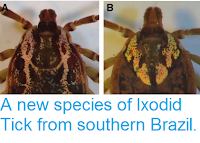Moss Mites, Oribatida, are tiny (0.2 to 1.4) Chewing Mites, with slow growth, long adult lives and low reproductive rate. They van be herbivores, fungivores, detritivores or carnivores, but there are no know parasitic species.
In a paper published in the journal ZooKeys on 4 October 2017, Nestor Fernandez of the Subtropical Biological Research Institute of the National Council of Scientific and Technological Research of Argentina and the Research Unit for Environmental Sciences and Management at North-West University, Pieter Theron, also of the Research Unit for Environmental Sciences and Management at North-West University, Sergio Leiva of the Experimental Rural Agency of the National Institute of Agricultural Technology in Argentina, and Louwrens Tiedt of the Laboratory for Electron-Microscopy at North-West University, describe two new species of Moss Mites, from Cameroon and Costa Rica.
The first new species is placed in the genus Yoshiobodes, which is known from tropical regions around the world but has not previously been recorded in Africa, and given the specific name camerunensis, meaning 'from Cameroon'. The species is described from three female specimens collected from rotten wood and litter on Mount Kala in Central Province, Cameroon, at an altitude of between 800 and 850 m. These are between 296 and 312 μm in length, and light brown in colour, with a surface microsculpture of irregular polygons.
Yoshiobodes camerunensis. Adult female, with cerotegumental layer. Scale bars is 50 μm. Fernandez et al. (2017).
The second new species is placed in the genus Rugocepheus, which has previously only been described from Africa, and given the specific name costaricensis, meaning 'from Costa Rica'. The species is described from three female specimens collected from soil beside an Ant's nest under a Panama Rubber Tree at an altitude of about 570 m on Mount Turrialba in Costa Rica. These range from 489 to 515 mm in length, and are brown in colour, with a microsculpture of tubercules covering the body.
Rugocepheus costaricensis. Adult female in dorsal view. Scale bar is 100 μm. Fernandez et al. (2017).
See also...
Follow Sciency Thoughts on Facebook.








